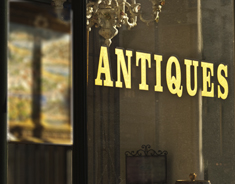March 3, 2015
Investing in art and antiques can be more enjoyable than other types of investing. But special expertise is necessary to make it profitable.

Investing in artwork can be volatile short-term because what’s “hot” in art fluctuates. Antiques are less volatile.
Experts recommend that investors educate themselves. For art, it is important to educate yourself generally about the art world, read art publications and research artists that interest you. The more you know about the art world, the better positioned you will be to invest. Even if you have an avid interest in and appreciation of art, and you have educated yourself, the advice of an expert is important to know what to buy.
When prices are negotiable, help from someone experienced in negotiating art purchases is helpful. However, choosing a trustworthy art expert to advise you requires some due diligence. Is this person being paid by a gallery? Does this person have reason to promote a particular artist or gallery?
Investing in antiques also requires expertise. Of course, you can buy what you like and enjoy it in your home, but if your goal is to maintain or increase the value over time, you need knowledge.
Experts recommend learning about the “high end” of the market first. You can read books about antiques and visit local museums, antique malls, antique stores and auctions. You can even learn from reality TV shows about antique-hunters.
Once you understand the difference between a treasure and items that are simply “old,” you’ll have a better chance of spotting a treasure hidden in an estate sale or flea market, although that doesn’t happen often.
An experienced antique dealer can help you determine what’s valuable, what isn’t and what specific pieces are worth. An antique dealer can provide guidance on what kinds of pieces you seek out to buy for investment.
Art investors must be on the lookout for fraud. It is important to determine the provenance of a work of art. Just because there appears to be appropriate paperwork doesn’t mean that what is being offered is what the seller claims it is. Usually, if a deal is too good to be true, it may well be a scam.
Art investments can require appraisals, storage, and auction or gallery fees, all of which have to be factored in when determining whether the investment will be profitable. Art also is subject to risks that affect its physical condition, so to maintain value, the art must be properly cared for, which adds to the costs of investing. Sunlight, humidity, heat, cold and other factors can affect the condition of art.
Investors also need to have their art insured. A good insurance company can provide advice on how to care for the art in a way that properly preserves it.
It is possible to invest in art purely to have it as part of your portfolio, and a lot of trouble and expense can be avoided by investing in an “art fund.”
Art funds provide more diversification than you are likely to have investing on your own. They provide the expertise and take care of all of the storage, restoration, transportation, security and insurance issues.
Some art funds are more aggressive than others, and some can specialize in certain periods, regions or artists. However, all of them tend to have long holding periods and not much liquidity. Art funds are relatively new and many have failed, so there is risk involved.
Is art a good investment compared to other investments?
According to Melanie Gerlis, writing in Art Market, Jan. 2014, “the lack of transparency on prices – makes true comparisons to assets such as public equity, gold, property and wine very difficult.”
Interestingly, it appears that the wealthy mostly buy art because they like it. According to 2,000 affluent individuals surveyed by Barclays “Wealth Insights: Profit or Pleasure?” for a June 2012 report in Forbes magazine, only 10 percent said they bought fine art purely as an investment.
Art is considered a collectible and generally will be taxed at the higher capital gains rate of 28 percent, or at the rate for ordinary income if held less than a year.
This article was originally posted on March 3, 2015 and the information may no longer be current. For questions, please contact GRF CPAs & Advisors at marketing@grfcpa.com.